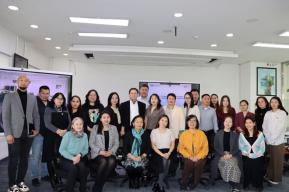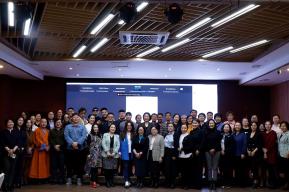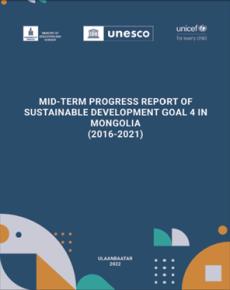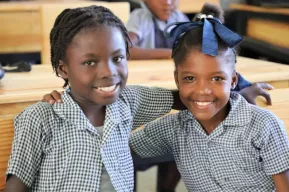News
Q&A with the Minister of Education of Mongolia on the evolving right to education
UNESCO asked five questions to H.E Mr Enkh-Amgalan Luvsantseren, Minister of Education and Science of Mongolia, on how the state of the right to education, and its evolution in his country.

What are the main challenges to education in your country?
When I took the portfolio of the Minister of education and science, the government embarked on revision of the education bill to refocus the education system on improving quality and outcomes for students. Meantime, the international communities were instrumental in providing a policy recommendations on the education system reform.
In 2019, with UNESCO’s technical assistance, Mongolia undertook a comprehensive analysis of the sector, identifying both strengths and weaknesses in the implementation of educational rights for the Mongolian people. This analysis yielded a wealth of insightful recommendations, laying a solid foundation for the subsequent revisions of our education laws.
As you imagine the Minister of education position is complex and multifaceted. It involves being a politician, a representative, a decision-maker, and a leader. And, it involves operating in the contentious, emotional field of education. After two years of intensive and wide-range of consultations, the Parliament of Mongolia has adopted the set of education laws, which provides a pathways for transformation education system in coming years in line with the Government long-term sustainable development vision -2050.
Advancing equity, efficiency and outcomes are the key challenges of the education system, which was revealed in recent PISA -2022 results, indicating an achievement gap exists in Mongolia that tracking leads to differential school experiences.
What are the key achievements in education in Mongolia?
Mongolia has achieved remarkable progress in education over the last 25 years. Mongolia has achieved impressively high rates of enrollment in education. Education access strategies have been implemented with success, particularly in relation to basic education, where enrollment rates are nearly universal at 98.5% (UIS, 2019). Pre-school coverage is almost 94.8% among children aged between 3-5 years old.
Moreover, last years, Mongolian education system undergo a deep transformation including modifying pre-primary, primary and secondary education curricula, vocational education and training, higher education and program content, revising student textbooks and learning materials, establishing a favorable learning environment, introducing universal kindergarten, transition from access to quality, realization of lifelong learning for all through the establishment of a National Qualifications Framework, introducing new educational digital platforms, ensuring learner’s right to internet access and digital devices.
How has the right to education evolved in Mongolia?
Since joining this legally bunding international instrument dedicated to the right to education in 1964, Mongolia has continuously demonstrated a strong commitment to making this right a reality.
In July this year, Mongolia's parliament passed a historic and groundbreaking set of education laws that make the right to education under the 4A framework a reality.
These laws represent a significant overhaul of our national education system, aiming to guarantee quality education and lifelong learning for all our citizens. This extensive and unified package of reforms was largely inspired by UNESCO's insightful policy analysis and recommendations. I am therefore profoundly grateful for UNESCO's support and partnership in these efforts.
What is your vision of transforming education?
Under the lens of its latest strategic reforms, Mongolia is set to transform the face of its education system significantly, with a new legal framework is being implemented from the academic year 2023-2024 onwards. The change is not just intended to invigorate the educational ground of the nation but also to make it more diversity-oriented, accessible, and future-ready. In other words, the education system should be moved from current state to totally new environment.
Through this vision, Mongolia aims to meet international standards, remarkably contributing towards accomplishing global agendas such as the Sustainable Development Goals. This ambitious transformation will cover everything from preschool education to higher scientific research. The inclusive design of the transformation acknowledges and advances the incorporation of early childhood education, vocational training, and adult learning, thereby addressing a comprehensive spectrum of the populace.
Mongolia’s ambitious plan to transform its education sector is not just a local agenda; it is a reflection of the global aspiration for delivering quality education to every child. If successfully implemented, it can prove to be a shining example for many nations embarking on a similar journey of educational reforms.
What is your message to teachers and learners?
The transformation of education begins with teachers. This reminds us that teachers and educators deserve to work in a supportive environment, have access to professional development, and be empowered to be innovative and creative to ensure their students can succeed. There was one question on my mind: "Why are some systems more successful than the rest? I believe it is the quality of teachers. Today’s educators are preparing students for jobs that don’t even exist yet. As such it’s of utmost importance to arm our students with the gift of critical thinking.
In this era of digitalization and transformation, both students and educators are expected to develop multidimensional competencies. Today’s learners are hungry to learn, learns as needed, anywhere, anytime, overwhelmed and distracted.
Today’s students must be collaborative, lifelong learners who are open and willing to adapt to an ever-changing environment. The competencies for the modern learner are creativity, innovation and entrepreneurship, collaboration, communication, learning to learn, global citizenship and critical thinking and problem-solving.







